Inside the New Caesar Guerini Invictus
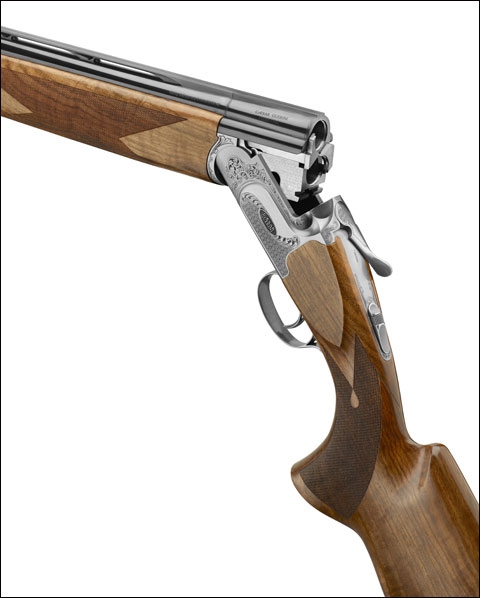
The Invictus is a shotgun, but where did that name come from? Seems like an unusual name for a shotgun. One clue to find out the meaning of Invictus would be to go to the maker — Caesar Guerini. They’re based in Brescia, Italy so that gives us a clue. Digging a little deeper, Invictus has its roots in Latin. You remember Veni, vidi, vici don’t you? Caesar’s “I came, I saw, I conquered!” The translation from Latin to English for Invictus is “unconquerable.”
Now Invictus sounds like a better name than what you thought a few seconds ago. Since the manufacturer is Caesar Guerini you probably know that this company has never made anything but over and unders — thus the Invictus is an over/under. Initially this model is only offered in 12 gauge, plus this one is aimed at sporting clays shooters, though I’m certain this over/under would fare well alongside a Cordoba, Argentina sunflower field, or a flooded rice paddy near Stuttgart, Arkansas – in case you think it’s OK to take your $6,700 over/under duck shooting. Obviously, the Invictus will be most at home on a sporting course, a Saturday morning 5-Stand, in the little FITASC hula-hoop circle, swinging fast on dizzying Z-Birds, ready for the live pigeon ring – as well as on a trap or skeet field.
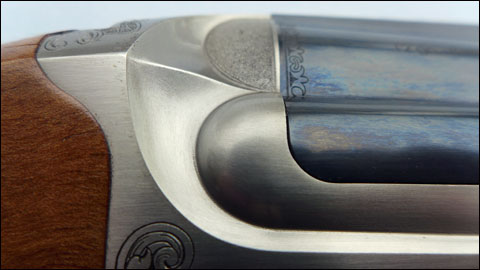 Note the deep and attractive sculpturing of the fence area on the Caesar Guerini Invictus.
Note the deep and attractive sculpturing of the fence area on the Caesar Guerini Invictus.Interestingly, the more you shoot an Invictus the more return you get on your $6,700 investment. Why is that? Because this shotgun is intended to last forever. That’s the theory behind its unique design. It may take decades to find out if the Invictus will last a million rounds and more, but I’m guessing the possibilities are high. Let’s take a look at why.
But before we can do that we have to dispel some misconceptions. Most of us shotgunners have long lived under the concept that shotguns wear out because their “bolting” systems wear out. This is not true. Stay with me.
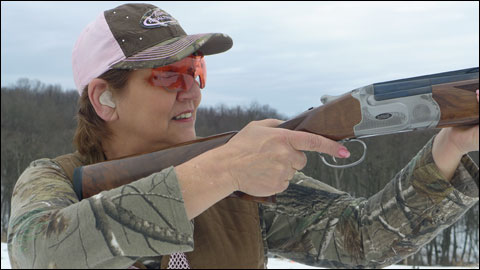 Marie Palmer prepares to put the prototype Caesar Guerini Invictus to the task.
Marie Palmer prepares to put the prototype Caesar Guerini Invictus to the task.Many of today’s over/unders have trunnions on the inner sides of the receiver – trunnions that the barrels pivot on. Some have cross bolts, like the Browning Superposed, Citori and a few others — on which barrels pivot on. Then there are the bolts that extend forward from the base of many receivers — that lock into recesses or lugs milled into the bottom of the monobloc upon closing. Some over/under designs have round or nearly round bolts (or pins) that protrude from the breech face to nestle into female recesses in the back of the monobloc such as Perazzi, Zoli, Beretta and a few others.
Most of us, me included, have spent our shooting lives thinking that the locks I’ve just described are responsible for a double gun holding up for thousands and thousands of rounds. Again, this is not true. The locking bolts keep the gun from opening upon firing. The trunnions or cross bolts arrest some forward movement of the barrels upon firing, but the biggest strength factor in keeping the barrels and the receiver tight together is the recoil lug or recoil lugs – as some designs have more than one recoil lug.
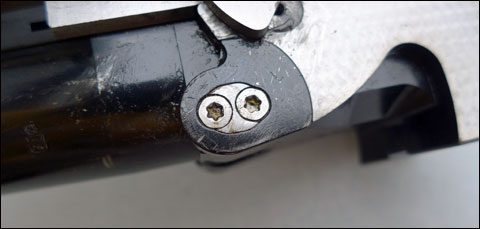 This is the Invictus Cam that barrels pivot upon — easily removed and inexpensively replaced.
This is the Invictus Cam that barrels pivot upon — easily removed and inexpensively replaced.In most systems the recoil lug(s) is milled into the bottom of the monobloc. These recoil lugs nestle into recesses milled into the bottom of the receiver. In the case of Browning’s Superposed, Citori and maybe a few others — the recoil lug nestles into open holes milled all the way through the receiver. In the Boss style like the Perazzi and Zoli the recoil lugs on the monobloc are on the sides — and they nestle into matching areas on the inner side of the receiver upon closing.
It’s when these recoil lugs wear out that they are no longer tightly together upon closing; this means the barrels are no longer tight to the breech face. Of course wear can also occur to the areas the recoil lug(s) nestles into. Probably, wear eventually occurs to both areas. When this happens with a typical double gun — it’s worn out — really no longer safe to shoot. There are a few gunsmiths, who might be able to try and rectify this situation, but they are few and far between, and, if fixable, it’s going to be expensive.
 The bright metal inside the receiver is the Invictus Block – easily removed via the two screws — and inexpensively replaced — allowing the Invictus to last for who knows how many more thousands and thousands of rounds.
The bright metal inside the receiver is the Invictus Block – easily removed via the two screws — and inexpensively replaced — allowing the Invictus to last for who knows how many more thousands and thousands of rounds.Surely trunnions, cross bolts and bolts that extend from the base of the receiver or pin-type bolts in the Beretta, Perazzi and Zoli systems can be replaced, and some action tightening can take place through that type of fix. But when the recoil lugs wear out the gun is worn out. It’s time to buy a new gun. Of course, if we’ve fired that gun a half million times we’re probably ready to relegate that treasure to the back of the gun cabinet.
 The Invictus schematic.
The Invictus schematic.No need to — and this is where the Caesar Guerini Invictus comes in. Instead of trunnions like all the other Caesar Guerinis the Invictus has Invictus Cams. Check the schematic. The green parts on the schematic are where and how the barrels pivot to open and close. While trunnions are replaceable it takes some gunsmith time and effort to replace worn ones — with slightly larger trunnions. Note the two purple screws in the Invictus Cam schematic. What could be easier — just remove those two screws, remove the Invictus Cam, replace with a slightly larger one, retighten into place with the same two screws — thus a very inexpensive fix.
Now look at the red area of the schematic. This is the Invictus Block in the bottom of the receiver. When the gun closes the recoil lug from the base of the Invictus monobloc nestles in behind the Invictus Block to form the super tight lock up that lasts for thousands and thousands of rounds. But there are also two screws in the Invictus Block. Shoot this over and under until the barrels are no longer tight to the breech face – maybe 500,000 rounds or more before that happens, and then send it back to Caesar Guerini USA in Cambridge, Maryland. They remove the two screws in the Invictus Block, exchange it for a slightly larger Invictus Block, and you’re back in business for who knows how many more hundreds of thousands of rounds. So relatively speaking you can’t wear out this over/under. Perhaps you’ll be able to shoot it millions and millions of times (along with your heirs) by just keep replacing the Invictus Cams and Invictus Blocks — sort of “from here to eternity.” By the way all Caesar Guerini over/unders come with a lifetime warranty, so maybe the price of shipping is all such a unique update will cost you.
 The new Caesar Guerini Invictus with updated Bottega Giovenelli engraving.
The new Caesar Guerini Invictus with updated Bottega Giovenelli engraving.Well, I had a chance to shoot it plenty — and with no problems — nor did I expect any. The Invictus had 30-inch barrels, although 32-inch barrels are available.
It handled as well as any other Caesar Guerini I’ve shot even though the receiver is slightly wider and thicker than other Caesar Guerinis, so there’s an ounce or more of weight between the hands — theoretically improving handling qualities. The Invictus weighed a tad over 8½ pounds and easily absorbed the recoil of the 1-ounce shells I used.
The company designed some additional tricks to also improve the gun’s liveliness. The trigger has newly designed sears and hammers to improve performance. Guerini also came up with a coating on them that adds lubricity so there’s a more “downy” feel to the trigger. The pull was crisp and fairly light.
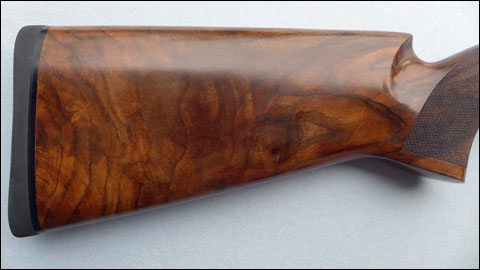 The Caesar Guerini Invictus will come with hand-rubbed, oil-finish Turkish walnut from the company’s Magnus Sporting shotgun. Laser-cut checkering is 32 lines-to-the-inch.
The Caesar Guerini Invictus will come with hand-rubbed, oil-finish Turkish walnut from the company’s Magnus Sporting shotgun. Laser-cut checkering is 32 lines-to-the-inch.The Invictus I shot was a prototype, one of four that had been taken to the 2014 January SHOT Show. There’s a new look to the deeply cut sculptured fence areas at the top front of the receiver. Except for the engraving pattern, this is essentially the gun you will see on dealer’s shelves — probably sometime in April. The engraving pattern has been updated by Bottega Giovenelli who has been responsible for all the Guerini engraving patterns to date. The receiver photo shows this new engraving pattern.
The Magnus is one of the most expensive Guerini models, so it has the best walnut. The Invictus will come with Magnus grade Turkish walnut, and it wears a traditional oil-rubbed finish. The Invictus had a rounded forend like the one on the Caesar Guerini Ellipse EVO.
Retained are the deep bluing to the barrels, the well jeweled sides of the monobloc, six screw chokes supplied, the rounded all-around recoil pad, the moveable trigger – all this for $6,700, the lifetime warranty, the possibility of the Invictus Block and Cam designs allowing for the firing of an untold number of rounds.
Nick Sisley’s new e-Books, “Nick Sisley Tests Sporting Shotguns,” “Nick Sisley Tests Hunting Shotguns” and “Nick Sisley on Shotgun Instruction” are available for only $2.99 each. Go to http://www.amazon.com. On the pull-down menu click “books.” Type in Nick’s name or a book title. Download to your Kindle or Fire. If you have neither, use the free Amazon App to download to you iPad or other electronic reading device or your computer. Nick welcomes your emails at nicksisley@hotmail.com.
Useful resources:
The web site for Caesar Guerini USA

Nick Sisley welcomes your emails at nicksisley@hotmail.com. Sisley has been writing full time for 43 years, his thousands of articles appearing in many, many magazines. He’s the author of eight books, is an NSCA, NSSA and NRA Shotgun Instructor and a pilot with many ratings.


Comments